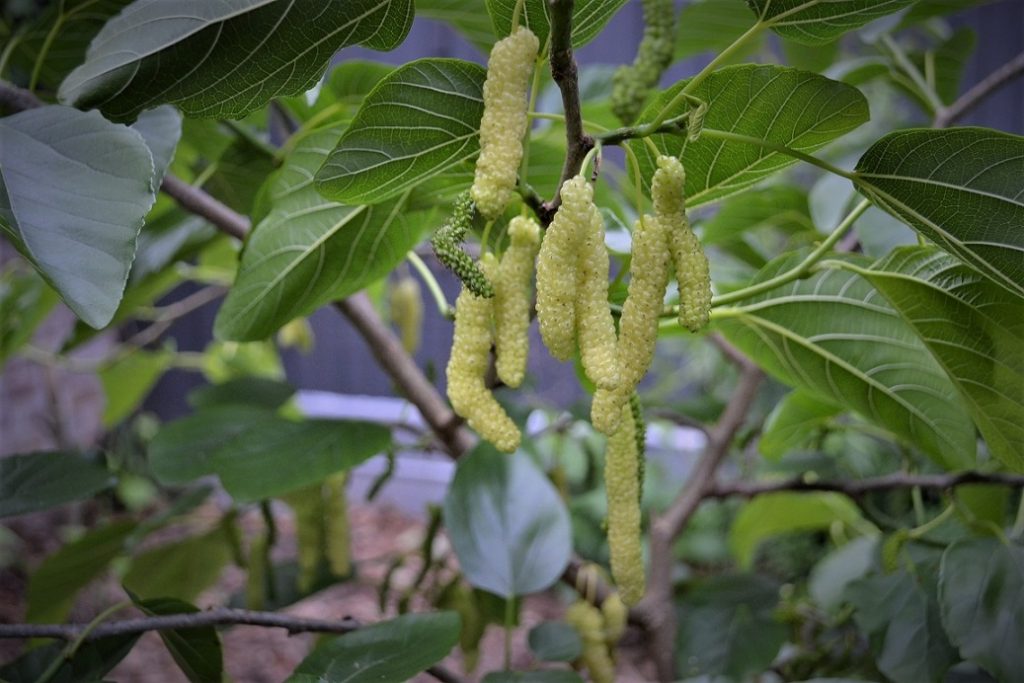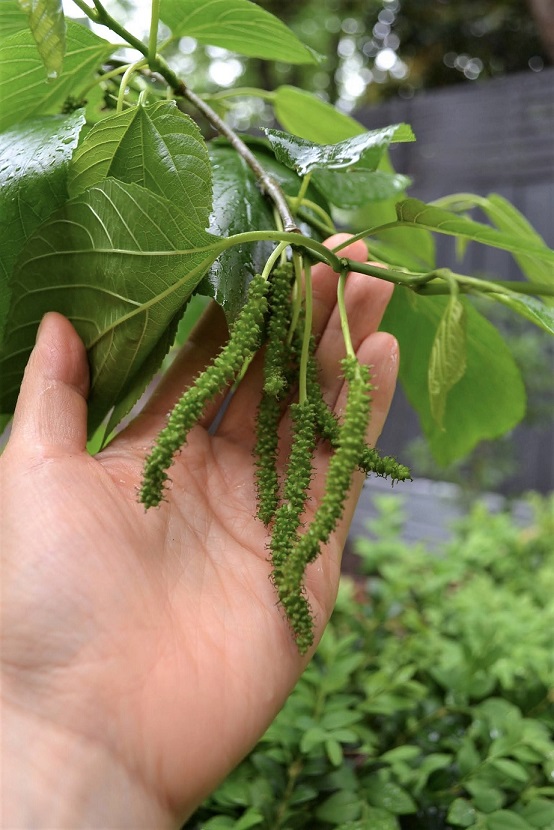
Every backyard should have a mulberry tree. They are such wonderful fruits and stunning ornamental trees. If you only have room for one mulberry, you have to grow the King White Mulberry. This is the largest and sweetest mulberry in existence and featured in our Top 5 must-grow berries.
We’ve had our tree for about 2.5 years now and it is starting to produce a bigger crop every year. We originally planted ours in a pot and transferred it to the ground last winter. It’s late autumn and our King white mulberry is flowering again! This tree never stops giving. Check out our video review for everything you need to know about this fantastic fruit and to see ours in action.
Fast facts
Name: The King White mulberry (Morus macroura ‘Shahtoot’) is also known as White Shahtoot Mulberry, Tibetan Mulberry or Finger Mulberry.
Origins: It is thought to have originated in China or Persia. The “Shahtoot” variety produces stunning long mulberries that are as sweet as honey.
Size: The White Shahtoot is a smaller tree than the Red Shahtoot, growing up to 4-6m height.
Climate: All climates – Cool, Temperate to Tropical and sub-Tropical climates
Growth habit: The White Shahtoot Mulberry has a subtle weeping shape although benefits from shape-training to enhance its weeping form and better fit into small spaces. We use string to tie down our branches, and you can do this with all trees. You can see how we do this in our video above. Mulberries can also be trained to a classic ‘espalier’ shape to save space.
Why you should be growing a King White Mulberry

1. Spectacular size and taste – The fruit on Shahtoot mulberries is incredibly delicious and spectacularly long, 3-4 times longer than standard mulberry. It is white and honey sweet, with lots of fruity notes resembling pineapple, apricot and the best of all fruits rolled into one. You won’t find a sweeter and tastier fruit. It looks impressive too and can grow as long as your finger, hence its other name “Finger mulberry”.
2. Mess free – Mulberries are notorious for staining and making a mess, but no such issue with the White Mulberry. Being white, you can safely plant it near your path or courtyard without risk of staining the pavers.
3. Get a few flushes of fruit each season – King White Mulberry is super prolific once established and with the right pruning technique, you can get several crops a season. Double the harvest of these delicious berries each year!
4. Ignored by birds – Being white in colour, the birds tend to ignore the berries. This means you can get away without netting the tree yet still have more fruit for you and less for the wildlife!
5. Fast fruit – Mulberries are great for impatient gardeners like me and will usually fruit in their first year back from the nursery. They are stunning ornamental trees and fast growers that will very quickly fill out a space. With their heart shaped leaves and their stunning autumn colour changes, they are well worth growing even for their looks.
6. Easy to grow – Mulberries are tough and hardy trees that can live for over 100 years. They are healthy and low-fuss trees, not bothered by many pests.
7. Functional and pretty– Being a deciduous tree, its leaves undergo a colour change in autumn from green to yellow. It is also a useful tree for a food forest as it drops its leaves and lets abundant light in during winter, while providing lush summer shade for your garden.
Mulberry growing tips

1. Light/shade: Mulberries don’t need full sun and can grow and fruit prolifically in a part-shade location. They also aren’t fussy about soil types. However, they will produce more berries in a rich well-draining soil enriched with compost, worm castings and manure.
2. Fruit drop on mulberries: In the first few years, it is natural for mulberries to drop fruit – don’t be alarmed. This is a natural characteristic of young mulberries to drop immature fruit. As the trees mature, they will produce bigger crops each year, and drop less fruit.
3. Watering: Once established, they are quite drought tolerant and won’t need a lot of supplemental watering. However, for bigger fruit and berries, ensure that they do not dry out during their fruiting season.
4. Ripening: In our temperate climate, in early spring our mulberries produce long spiky looking clusters of fruit, which are technically the flowers of the mulberry and are called “catkins”. They are long and green with soft white spikes on them. These gradually plump out during spring, turn white and develop a fruit aroma, and become plump delicious white Shahtoot mulberry fruit.
7. Harvesting: We harvest our fruit throughout late Spring and early summer. A trick to get your mulberry to produce more fruits is to prune the tips of every fruiting branch as soon as they have fruited. The pruning will stimulate fresh growth from with new berries will form. This will encourage your tree to produce a second to even third flush of fruit, meaning you have delicious berries to enjoy all summer and into autumn.
8. Autumn colour change: In late autumn / early winter, the leaves on your tree will turn a stunning yellow before they drop and the tree goes into its winter dormancy. In warmer climates, the tree may not entirely drop its leaves in winter.
Thank you for the info, its great! Where can I buy this type of plant or cutting ?
Thank you,
Jennifer Z
As a fellow backyard gardner in Sydney, thanks for presenting the content in a well structured way. I haven’t seen anyone mention the point about white mulberries being less of a bird attractor.
Keep up the good work.
Hi Jian!
I’m from India.
Thanks for posting the information on uses and growing kings white mulberry.
A mulberry sapling bought from nursery started giving these white shatoot mulberry which I have never seen before.
After googling, I came across your site which gave me useful information.
Thank you once again.